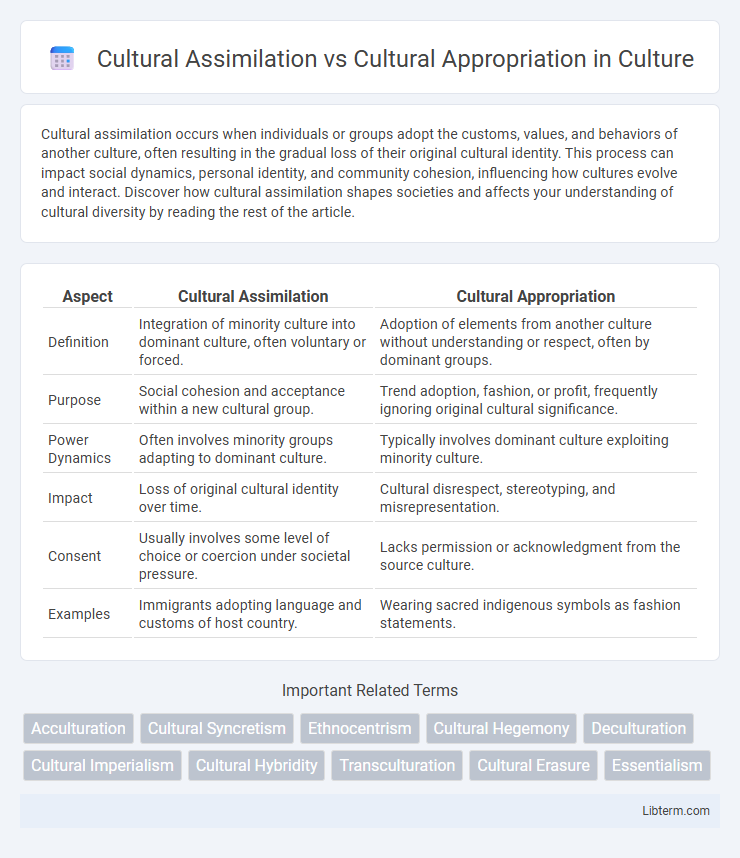Cultural assimilation occurs when individuals or groups adopt the customs, values, and behaviors of another culture, often resulting in the gradual loss of their original cultural identity. This process can impact social dynamics, personal identity, and community cohesion, influencing how cultures evolve and interact. Discover how cultural assimilation shapes societies and affects your understanding of cultural diversity by reading the rest of the article.
Table of Comparison
| Aspect | Cultural Assimilation | Cultural Appropriation |
|---|---|---|
| Definition | Integration of minority culture into dominant culture, often voluntary or forced. | Adoption of elements from another culture without understanding or respect, often by dominant groups. |
| Purpose | Social cohesion and acceptance within a new cultural group. | Trend adoption, fashion, or profit, frequently ignoring original cultural significance. |
| Power Dynamics | Often involves minority groups adapting to dominant culture. | Typically involves dominant culture exploiting minority culture. |
| Impact | Loss of original cultural identity over time. | Cultural disrespect, stereotyping, and misrepresentation. |
| Consent | Usually involves some level of choice or coercion under societal pressure. | Lacks permission or acknowledgment from the source culture. |
| Examples | Immigrants adopting language and customs of host country. | Wearing sacred indigenous symbols as fashion statements. |
Understanding Cultural Assimilation
Cultural assimilation involves the gradual integration of individuals or groups into a dominant culture, often resulting in the adoption of language, customs, and social norms. This process can promote social cohesion and reduce cultural barriers but may also lead to the erosion of original cultural identities. Understanding cultural assimilation requires recognizing its complex dynamics, including voluntary adaptation and pressures exerted by societal institutions.
Defining Cultural Appropriation
Cultural appropriation involves the adoption of elements from one culture by members of another culture, often without permission or understanding, leading to misrepresentation or disrespect. It typically occurs when a dominant group borrows from a marginalized culture, resulting in the commodification or trivialization of significant cultural symbols. Unlike cultural assimilation, which is the integration and blending of cultural identities, cultural appropriation exploits cultural aspects without acknowledging their original context or significance.
Key Differences Between Assimilation and Appropriation
Cultural assimilation involves adopting elements of another culture, often voluntarily or through social integration, resulting in a blending or merging of cultural identities. Cultural appropriation occurs when elements of a marginalized culture are taken out of context by members of a dominant culture, often without permission, leading to misrepresentation and exploitation. Key differences include power dynamics, intent, and respect; assimilation is typically about inclusion and adaptation, whereas appropriation involves disrespect and reinforces systemic inequalities.
Historical Examples of Cultural Assimilation
Cultural assimilation historically occurred during European colonization when indigenous populations in the Americas and Australia were compelled to adopt European languages, religions, and customs, often through education systems designed to erase native identities. The forced assimilation policies in Native American boarding schools in the United States aimed to replace indigenous cultures with Anglo-American norms, causing loss of native languages and traditions. Similarly, in Australia, the Stolen Generations experienced cultural assimilation through government policies that separated Aboriginal children from their families to integrate them into white society.
Cases of Cultural Appropriation in Modern Society
Cases of cultural appropriation in modern society often involve fashion brands adopting Indigenous patterns without permission, leading to public backlash and calls for respect and compensation. Celebrities have faced criticism for wearing traditional attire or hairstyles from marginalized cultures, which many view as exploitation rather than appreciation. Social media platforms amplify these controversies, fostering global discussions on the ethical boundaries between cultural exchange and appropriation.
The Role of Power Dynamics
Cultural assimilation and cultural appropriation both involve the interaction between dominant and minority cultures, but power dynamics play a crucial role in distinguishing them. Assimilation occurs when marginalized groups adopt the dominant culture's traits, often due to social pressure or institutional coercion, leading to loss of original cultural identity. Cultural appropriation involves the dominant group adopting elements from a marginalized culture without understanding or respecting its significance, reinforcing power imbalances and perpetuating stereotypes.
Impact on Minority Communities
Cultural assimilation often results in minority communities losing their unique traditions and languages as they adopt dominant cultural norms, leading to diminished cultural diversity and identity erosion. Cultural appropriation, on the other hand, involves dominant groups adopting elements of minority cultures without permission or understanding, which can perpetuate stereotypes and disrespect the original cultural significance. Both phenomena negatively impact minority communities by undermining their autonomy and diminishing their cultural heritage.
Cultural Exchange vs. Appropriation: Where’s the Line?
Cultural exchange involves mutual respect and understanding where elements from different cultures are shared and appreciated without exploitation. Cultural appropriation occurs when one culture adopts aspects of another, often marginalized culture, without permission or recognition, leading to misrepresentation and harm. The line is defined by context, intent, power dynamics, and respect, highlighting the importance of mindful engagement that honors the source culture's significance and agency.
Navigating Respectful Cultural Interactions
Navigating respectful cultural interactions requires understanding the distinction between cultural assimilation, which involves adopting traits from another culture often as a survival strategy, and cultural appropriation, where elements are taken out of context without respect or acknowledgment. Prioritizing authentic engagement with cultural customs, seeking permission, and educating oneself about the significance behind traditions helps prevent disrespect and fosters meaningful appreciation. Awareness of power dynamics and historical context is essential to ensure interactions honor cultural identities rather than exploit them.
Promoting Cultural Appreciation Over Appropriation
Promoting cultural appreciation over cultural appropriation involves respecting and valuing the origins, significance, and context of cultural elements rather than exploiting or misusing them. Engaging with diverse cultures through education, genuine interaction, and acknowledgment of their history fosters meaningful understanding and mutual respect. Encouraging thoughtful representation and collaboration helps celebrate cultural richness without perpetuating stereotypes or power imbalances.
Cultural Assimilation Infographic

 libterm.com
libterm.com